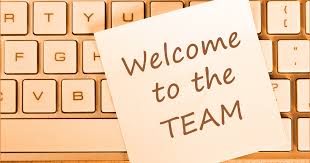Trying to figure out the best way to welcome a new employee? To begin, try to see things from their point of view. Like a new student at a strange school, when you first start a new job you want to know where your locker is and what classes you’re enrolled in, but what you really want to know is the culture and the rules of the workplace. The popular kids never raise their hands, and neither you. Just how do you plan on it? A new employee may be unsure of the company’s norms or how to navigate the workplace. Greeting them and introducing them to the rest of the team with anything as basic as a letter left on their desk or a message sent in Slack can go a long way. This post will go over some ideas for a new employee gift, letter, email, and announcement.
How to Welcome a New Employee
The purpose of a message of welcome to a new employee might take several forms. You can express your pleasure at them joining the team, explain the norms of the workplace, and highlight the qualities you admire most in them. Keep your correspondence brief and charming, whether it’s an email or a handwritten note. Here are a few ways you can welcome a new employee.
#1. Send a Welcoming Email
Writing a welcome email for your new employee is one approach to greeting them. However, Renée Solorzano, Director of Product Design at Faire, explains why sending a welcome email to a new employee is a great approach to making them feel at home.
You should also include the specifics of the job offer (such as salary, start and end times, parking instructions, and a dress code) in your initial email of congratulations.
#2. Promote Team Bonding With Coffee Breaks
The best way to welcome new employee to feel at ease is for current employees to extend invitations to them for coffee or a walk. While it’s possible to propose that new employees introduce themselves to team members, doing so on day one of a new job can be somewhat nerve-wracking. Having the rest of the staff take the new employee out for coffee can help them feel more integrated into the company and is a great opportunity to give them a tour of the workplace.
#3. Prepare the Training for the First Day
It is not acceptable for a new employee to spend their first day at work scratching their head and wondering what they are supposed to be doing. Update the employee handbook and get some training and other materials ready for the new employee. Doing so will demonstrate to the employee that you care about their success in their new position and are willing to invest time and effort to help them become up to speed quickly.
#4. Be Available and Patient
Any new employee will experience a period of adjustment. That’s why it’s crucial for managers to be accommodating and available to their new staff members whenever they have questions. You should reassure your new hire that they are not alone in their confusion and that you will be there to answer all of their inquiries and provide assistance. Instructing them on the most effective method for posing their inquiries is a must (i.e., via instant chat, email, and phone call).
#5. You Should Check That They Have All They Need Before the First Day
Make sure that everything that the new hire will need is ready and waiting for them on their first day of work. This includes a parking pass, swipe card, technology, a set-up desk, copy machine instructions, and any other tools or resources. Nobody likes to feel insignificant and out of place when they first start a new job and nothing has been prepared for them.
How Do You Write a Short Welcome Message?
A heartfelt word of welcome can make all the difference when someone is starting a new job as a new employee. These are messages that are both uplifting and informative, often giving the new employee crucial details about their first day. Here are the broad strokes to keep in mind when writing such a note:
#1. Start With a Distinct Assertion
Go right to the point by starting with a statement that explains your motives. Welcome aboard! or “Thanks for picking us!” are two phrases that could go here. If you’re writing an email, you might use this first sentence as the subject heading. By doing so, you can guarantee that the new employee will see your email among the many other messages they receive in the days leading up to their first day.
#2. Be Mindful of the Letter’s Tone
You should pay attention to the overall tone you want to convey in your note. It’s up to you if you want to be professional or casual about it. You may get away with using less formal language when talking to a coworker because you already know each other well. Use a more official tone if you’re writing to welcome a subordinate. Writing your letter in a way that fits in with the company’s culture is also important. Many businesses have vastly different cultures, with some being extremely professional and others casual and fun.
#3. Demonstrate Your Gratitude
Send the new hire a message that you have faith in their talents and are happy to have them on board. As a result, they will have a better first-day experience overall. In addition, you may want to emphasize once more why they are a good fit for the position they are applying for. Maintain an upbeat and encouraging tone throughout the letter.
#4. Remember to Include Relevant Details
When writing your letter, it is also vital to consider how much detail you want to provide. A brief letter of welcome is OK, but it may be worthwhile to include some key information for the new employee at the end of your message. This data may include specifics on the employee’s first day on the job. Give them specific instructions on how to get to the office, who they should see first, what they should wear, and whether or not they need to bring any special paperwork with them (such as a passport) when they arrive for their first day.
Welcome New Employee Letter
The purpose of a first-day letter or email is to welcome and inform new employees about their upcoming first day on the job. It needs to be tailored to the individual, containing details about why they were hired.
Furthermore, when a new employee is hired, it’s crucial to formally welcome them to the company and supply them with the required onboarding information and paperwork. An excellent and easy approach to welcoming them is to send a welcome letter or email to new hires.
What Is a New Employee Welcome Letter?
A permanent employee welcome letter is a document that a company sends to a new employee to welcome them to their new workplace, team, and organization.
Together with a cordial greeting, a welcome letter is issued to new hires that also provides important details about their first day on the job. These emails can also improve staff motivation and satisfaction.
However, each email exchange after a candidate has formally accepted a job offer is regarded as a welcome to the employee. Each is important for successfully beginning the employee journey.
What to Add in a Welcome Letter to a New Employee
A letter of welcome can be as brief and straightforward as it is lengthy and intricate. The letter’s purpose determines its length and the details it contains. A company may use the welcome letter simply to extend a warm greeting and let the new employee know when and where the onboarding will take place, while others may use it to provide useful resources like links to corporate policies and forms.
In your introduction letter, please provide the following details:
- A very positive comment
- Introduce yourself and your current role.
- Fundamentals that you really must be aware of
- A confirmation of the employee’s scheduled start time
Some optional parts to consider adding are as follows:
- Schedule for new employee orientation and/or onboarding
- Details about your closest coworkers’ names and jobs
- A typical day in the life
- The enrollment application links
- Webpages with access to the manual for workers
- Information and access to various tools and resources for employees
The Importance of Sending a Welcome Letter to a New Employee
A welcome letter is a great way to show respect and get to know a new employee’s interests. Your new employee will have more faith in their decision to work for you if they are greeted warmly upon their arrival. It is common knowledge that receiving a welcome letter from a new company helps new hires feel more relaxed and enthusiastic about their first day on the job.
In addition, you can use a welcome letter to share information about the onboarding process, corporate regulations, employee introductions, and anything else that will make the new hire’s transition to your organization easier.
How to Write a Welcome Letter to New Employees
To start off your first welcome letter, follow these steps:
#1. Put the Topic Line First
The most efficient email subject lines are those that guarantee some sort of benefit.
To rephrase, your letter’s subject line ought to sell the reader on the idea that it contains useful, engaging content.
The following phrases may be used as topic lines:
- It’s great to have you on board, [new employee name].
- Here at [company name], we couldn’t be happier to have you on staff.
In addition, ensure that your subject line is free of spelling and grammatical mistakes so as to preserve your credibility with your readership.
#2. Exhibit Energy and Excitement
The best thing a boss or HR manager can do is to show new hires they share their enthusiasm about them joining the team.
So, adopt a welcoming attitude rather than one of aggression, and give new hires a taste of the kind of environment they may expect to find here.
“Enthusiastic” (or a close equivalent) is the word we suggest using in this situation. So rather than using an exclamation mark, you might just describe your excitement with words like “thrilled” or “excited.”
Expressions of excitement can be made with very few words. Keep in mind that overly enthusiastic language, such as an abundance of exclamation marks, can divert attention away from the main point of your speech.
Also, if you’re going to punctuate that phrase with an exclamation point, don’t use “excited” or a similar word; it’s overused, it’s repetitious, and it might make you look unprofessional.
Furthermore, using first names throughout emails gives new hires the impression that they are communicating with a real person rather than a computer.
This can help your new employees feel more comfortable approaching you with questions and ideas. After coming to you, people will feel more at ease and willing to discuss their issues with you. Also, read EMPLOYEE ONBOARDING: What You Should Know About The Entire Onboarding Process.
#3. Include a Brief Synopsis of the Firm
New employees will feel more comfortable and at ease in their new role if they have a solid foundation of knowledge about the organization.
Your company summary should serve as a brief introduction to your organization.
You need to at least cover the basics when it comes to your company.
Company Title
- It is your company’s full, legal name.
Organizing a Company
- Your new worker will be curious as to whether your business is a sole proprietorship, an LLC, a partnership, or a corporation.
- In addition, please provide the addresses of your company’s main offices and any other buildings or land that the business owns.
Management and owners
- Find out who owns your business and how they are connected to it. To what extent does each shareholder own the business?
- Make sure the company is aware of the identities and primary responsibilities of your highly active management team.
A Proven Track Record
- The length of time you’ve been in business is a unique selling point for your organization.
- It’s acceptable to inject some individuality and quirkiness, so long as they’re relevant to your company’s culture.
#4. Discuss Fundamental Principles
When a business is going through a period of transition, struggle, or change, having a set of common core values can help guide decision-making and keep the team motivated.
Employers can also screen potential workers for compatibility with the company’s guiding principles by basing hiring decisions on application and interview responses.
Consequently, it is crucial to highlight your most cherished principles in your opening letter. In a brief bulleted list, you can convey your company’s core beliefs without overwhelming your reader.
Below are some examples of core beliefs that your organization might hold.
- Integrity: Everyone who represents the company and its activities must uphold the highest ethical standards.
- Honesty: Business practices that are honest and trustworthy are highly valued by customers, partners, and employees alike.
- Accountability: The best way to build trust with yourself and others is to accept responsibility for your actions.
- Diversity: When people from different backgrounds and points of view work together in an inclusive setting, everyone benefits.
As a more traditional, formal organization, you can show them how much you care by holding events where everyone dresses to the nines and enforcing strict standards about behavior.
#5. Discuss the First Day
It doesn’t matter how casually you write your welcome email; there are still some requirements. The first thing that should always be included in the welcome letter or email is the date and time of the new employee’s first shift.
Second, it’s crucial to keep your staff updated on the physical address of your organization at all times.
Let them know where they can park and the closest stations if they’re taking public transportation.
In today’s technologically advanced day, many businesses are adopting a remote work model; if your company follows this trend, make sure to provide your new hires with a crystal-clear video conferencing link so they can easily join their first meeting.
Finally, a first-week agenda, including a schedule of employee orientation sessions and team projects, should be included in your welcome email to new hires. This will help new hires feel more at ease and organized for their first week on the job.
Helping new employees become acclimated to the firm and its culture requires extensive training resources. Also, include links to the company’s handbook, code of conduct, dress code, mission and vision statements, and any other relevant documents in your email. You can add these files as attachments or provide external links in your email.
#6. Close the Letter
Now that you’ve included everything that needs to make it into your new employee welcome letter, you can wrap things up in a formal and polite fashion.
Because it’s the last thing your readers will encounter, it’s also important to leave a lasting impression.
- Letters between professionals should end with more formal closings such as “Sincerely,” “Best regards,” or “Respectfully.”
- While “Best wishes” and “Appreciate it” are fine for casual communications,
After that, you should introduce yourself with either your whole name or just your first name if you’re going for a more casual vibe.
Welcome New Employee Announcement
To help a new employee settle in, it’s a good idea to send out an email to the company informing everyone of their impending arrival, their responsibilities, and their work location. In addition, learning more about the new employee helps the rest of the staff welcome them warmly.
Furthermore, as an entrepreneur or HR professional, have you ever considered writing a new employee announcement email that works? Perhaps not. As such, the way in which new employees are welcomed can be a window into the company’s culture, values, and organizational structure. While starting work for the first time at a new company, a new employee naturally anticipates being treated with open arms.
In addition, Can you think of a time as a business owner or human resources manager when you sent out an effective email announcing the hiring of a new employee?
Perhaps not. As such, the way in which new employees are welcomed can be a window into the company’s culture, values, and organizational structure. While starting work for the first time at a new company, a new employee naturally anticipates being treated with open arms.
In addition, 82% of companies that have a good onboarding process see an increase in new hire retention.
What is a New Welcome Employee Announcement Email?
An email announcing a new hire is known as a new welcome employee announcement. It’s to formally welcome a new employee to the business.
Furthermore, When a new employee joins a company, the first thing they do is send out an email to the entire staff, copying the new hire. This email lets everyone on the team, even those who work remotely, welcome the new member.
Some firms spice up the first day on the job by introducing the new hire to the rest of the staff and showing them around the different departments.
This kind of action, however small it may be, always leaves a lasting impression. And this welcome email announcement of the new employee sets the stage for a productive and fruitful working relationship.
How Significant Is the New Employee Welcome Announcement?
Sending out a welcome letter to a new employee is a great way to make them feel at home in their new position. This is a crucial part of the onboarding process since it ensures that your new employee has all the resources they need to succeed. Providing new hires with an overview of the organization and its function will help them jump straight in and succeed.
There are many benefits to communicating your excitement about a new hire to the rest of your staff. To maintain employee productivity and interest, it is helpful to keep them abreast of corporate happenings and updates. Your team will be aware of the new hire’s role and how they will contribute to the company’s overall objectives. A new employee welcome announcement may not only improve internal communication, but also aid in the development of a culture where teamwork, openness, and respect are ingrained values.
What to Include in a New Employee Welcome Announcement Message?
An internal new employee welcome announcement letter should contain some crucial pieces of information. Some examples are
- Complete name and an alternate name of the employee.
- Their official title in the company.
- Specifically which group or division they’ll be joining
- If appropriate, the person or thing they are replacing.
- In the case of a brand-new opening.
- That whatever tasks will fall under their purview.
- This is where they’ll be based.
- How soon they plan to get started
- Details regarding their prior work and/or academic background.
However, it may be helpful to send a short questionnaire to your new employee before they begin their new role so that you can collect the necessary data for the new employee welcome announcement.
What Are Some Good Welcoming Messages?
Here are some good welcome messages for a new employee.
- Say something like, “Welcome to the team, [new employee’s name]! As a result, we are pleased to have you on board as one of the few people we’ve hired that we truly believe will contribute to the success of our company. We hope to be a part of your success story.
- Congrats and welcome! We’re anxious to see how you’ll make an impact here.
- We appreciate your acceptance of the position with [business] and want to assure you that you will fit in well with our team. Your ideas and input are highly valued, so don’t be hesitant to provide them.
- Congrats on your recent promotion! Our faith in your potential is what led us to hire you. We want you to be curious, to make blunders, and to take risks, so that together we might achieve even greater heights.
- Everyone at [Company] would like to extend a hearty welcome to you. We’re always looking for people who can contribute to the growth of our already strong, enthusiastic, and open-minded team, and we think you’ll be a great addition.
- A hearty “Hello and congrats, [name]!” If we bring someone onto our team, we’re invested in their future with us. We’re glad to have you join our team and look forward to assisting you in achieving your career goals.
- I’d like to personally congratulate you for selecting [business] as your new place of employment and extend a warm welcome to you, [name]. We’re so glad to have you on board as one of the gang.
- “Let me extend to you cordial and hearty greetings, [name]. If you’re here, it’s because we think you’re a good fit for the team and believe you’ll contribute positively.
Welcome New Employee Gift
Giving a new employee a thoughtful welcome gift that expresses gratitude goes a long way toward cementing a positive impression of your company as an employer and fostering a sense of camaraderie amongst team members. It creates an environment where employees can thrive. Also, doing so helps to instill the company’s ethos among new hires right away.
Photos of these presents can provide great examples of content promoting an organization’s brand. Perhaps it might be a part of their evaluation on Glassdoor, whether as a testimonial or comment. Moreover, expensive or not, there are many things you can gift to a new employee to welcome them.
What Is a New Employee Welcome Gift?
The goal of a new employee gift, also known as a welcome kit, swag bag, or onboarding package, is to make a firm’s latest employee feel welcome and happy about joining the company. Typical contents of the gift include imprinted swag like notepads and mugs that the new hire can use on the job. Whatever the firm thinks will make the new employee feel welcome and appreciated is fair game as a new-hire gift.
However, a gift for a new employee might be presented on or before the first day of employment to welcome them. The two may be combined, as is the case with some businesses. A Gift for the new employee is just one aspect of a larger welcome package that includes orientation materials, company background, and job information.
Here is some welcome new employee gift to consider.
#1. Welcome Message Written by Hand
Personalize the first day on the job with a handwritten note of welcome. It need not be extensive. Expressing your joy at the arrival of the new worker in a brief message will be enough. A postcard including a group photo and warm greetings from fellow team members is another option. Alternatively, it may be a message on the group’s whiteboard.
Furthermore, making new hires feel welcome by management and the team is key to retaining them. Clear Business found that retention rates for new hires were raised by 52% for companies with a solid onboarding procedure.
Welcome cards are a great addition to your presence because they can be made quickly, cost very little money, and make a big difference in the lives of your new employees.
#2. Headphones With Noise Cancellation
To assist new employees to focus on their work, a good pair of noise-canceling headphones is a great present if it fits within your budget. It helps to muffle ambient sounds and eliminate distractions like a noisy coworker or neighbor.
To minimize having to stop what you’re doing to charge your headphones, they should be lightweight and fast charging. So that they can listen to music without disturbing their coworkers, you should also seek an option with low sound leakage.
#3. Office Equipment
Whether they work from home or in an office, all desk employees need basic office equipment as part of their welcome package.
To ease the transition into the workplace, supply your new staff with the following:
- Office storage box
- Folders, envelopes, and business cards
- Staplers, paperclips, and scissors
- Post It notes
- Notebooks and notepads
- Pens, markers, highlighters
In order to keep workers’ desks from becoming needlessly messy, it’s important to provide only the supplies they actually need.
#4. Cookie Bouquets and Other Sweet Treats
When midday hunger strikes, it’s helpful to have access to cookies and snack packs.
Stock up on fresh fruit, nuts, vegetables, trail mix, granola bars, and beef jerky to improve staff health and happiness. Refreshments such as coffee, tea, and juices are necessities for many office workers and should be provided.
While putting up your welcome baskets, try to support local companies by ordering cookies or snack boxes from them if at all possible. When handing out cookie trays and snack boxes as a welcome to the team, it should be prudent to find out if any of the new hires have any food allergies or intolerances.
#5. Vouchers and Gift Cards
Since you probably don’t know what sort of things your new employees like or need just yet, gift cards are a great way to go. That way, people can choose the items that truly satisfy them.
Furthermore, employees can take use of the gift card’s shopping benefits, which can boost morale. They’re cheap, easy to make, and quick to disperse.
Typical options include certificates for a favorite eatery or coffeehouse in the area. Use an online or e-commerce business like Amazon to give your staff more options.
Also, gift vouchers are a wonderful and inexpensive way to welcome new employees, much like gift cards. You can get vouchers for things like staycation certificates, weekend getaway vouchers, meal subscription vouchers, and vouchers for fine dining.
Benefits of Presenting a Gift to Welcome a New Employee
Some concrete advantages of giving gifts to new employees to welcome them are as follows:
#1. Enhances Interest
It’s common practice to give corporate presents to new staff members in anticipation of their first day on the job. Employees’ excitement and mental preparation for their new job are both boosted by receiving a welcome present. When they get started, they’ll be energized and productive.
#2. Integrates Company Values and Reputation
Get the word out about what makes your firm special. If you want to convey your chill vibes, send a coffee mug with a clever saying on it. You might also gift blue-light-blocking glasses to show how much you care about their health and comfort. In addition, it serves as a model of giving and kindness for the new hire to emulate.
#3. Facilitates a Sense of Team Spirit Among Workers
One way to help new hires feel more welcome and integrated is to provide them with business t-shirts to wear on their first day. Nobody should feel left out of the group’s camaraderie, thus the corporation should provide uniform stuff for everyone.
Conclusion
Accepting a new crew member ought to be a joy. More people are always better when it comes to creating encouraging welcome aboard messages for a new employee. Try some of the suggestions or come up with your own. Even better, incorporate sending out welcome emails into a regular part of your company’s onboarding procedure.
Also, an email or letter to welcome a new employee is a fantastic opportunity to introduce that person to the team and the company’s culture, provide them with the information they’ll need, and make them feel like they’re part of the group.
It’s crucial that the new employee be enthusiastic about joining your company and working with you in your welcome communications. Keep in mind that each new employee only has one “first day,” so make it count.
FAQs
Who should the welcome letter be from?
The senior executive who writes the letter of introduction might be anyone, depending on the nature of the new hire’s role at the organization. Also, a member of human resources may write a welcome letter, but managers or the CEO may also send one.
How should I send the welcome letter to new employees?
The most appropriate method of delivery of this letter to the employee will depend on the contents and the deadline for its receipt. Furthermore, email is commonly used for sending welcome letters because it allows for easy integration of links to internet resources like the employee handbook and internal messaging software. When it comes to making a good first impression, some businesses believe that sending a welcome letter by regular mail is the way to go.
Similar Posts
- DRIP CAMPAIGN: A Guide to Drip Campaign Marketing
- Credit Card Churning: Definition and How It Works
- EMAIL MARKETING TOOLS: The Top 10+ Automation Tools (+Free Tips)
- TOP 13+ SKATEBOARD BRANDS With the Best Reviews in 2023(Updated!!!)
- VERBAL HARASSMENT: Meaning, Example, Workplace & Law






